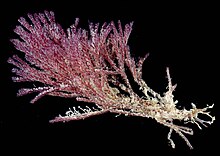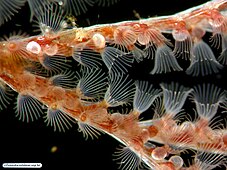| Bugula neritina | |
|---|---|

| |
|
Scientific classification
| |
| Domain: | Eukaryota |
| Kingdom: | Animalia |
| Phylum: | Bryozoa |
| Class: | Gymnolaemata |
| Order: | Cheilostomatida |
| Family: | Bugulidae |
| Genus: | Bugula |
| Species: | B. neritina
|
| Binomial name | |
| Bugula neritina | |
| Synonyms [2] | |
|
Sertularia neritina Linnaeus, 1758 ( basionym) | |
Bugula neritina ( commonly known as brown bryozoan or common bugula) is a cryptic species complex of sessile marine animal in the genus Bugula. [2] It has a practically cosmopolitan distribution, being found in temperate and tropical waters around the world, and it has become an invasive species in numerous locations. [3] [4] It is often found in hard substrates, such as rocks, shells, pillars and ship hulls, where it can form dense mats, contributing to biofouling. [5] [6] B. neritina is of biomedical interest because it harbors a bacterial symbiont that produces a group of bioactive compounds with potential applications in the treatment of numerous diseases. [7] [8] [9]
Biology
Description
B. neritina forms fouling colonies of brown-purplish color, [5] it feeds itself with particles in suspension for being a sessile animal. Besides that, its zooids (individuals that compose the colony) are white, with a pointed exterior corner and differentiates itself of the other species of the genus by not presenting the following zooids: avicularium and spine zooids. [10]
The colonies tend to live more than one year, and their zooids are hermaphrodites, with the dispersion of gametes in different times of life, avoiding self fecundation. [11]
In their life cicle, a zooid is originated by sexual reproduction and develops the colony by budding, the fixation is done the whole year, with exception of the period of mid-winter, by the lecithotrophic larva. It is valid to point out that B. neritina is hermaphrodite. [5]
Phylogeny
The Bugula neritina species is inserted in the clade Lophophorata due to the presence of a lophophore, a feeding structure that is the synapomorphy characteristic of the group. Phylum Bryozoa, class Gymnolaemata and order Cheilostomatida, as the external wall is calcified. They belong to the Bugulidae family and the genus Bugula. [2]
Distribution

The Bugula neritina species, one of the first bryozoans to be discovered and considered as the type species of the Bugula genus, [12] are colonial and marine animals, with a wide geographical distribution. They are actually considered a complex of three crypitic species, morphologically equal, but with a few genetic differences, and the haplotype S1 is the most distributed. [4]
They are virtually cosmopolitans and, in many regions, invasives, once they can be found in almost the whole globe, with exception of the north and south poles, subartic and subantartic, [3] being commonly present in the costal regions of the North Pacific and North Atlantic; in Australia, New Zealand, United States and Hawaii, Mediterranean Sea and even in Brazil. [11] These animals have preference for shallow and warm waters, between 10 and 30 °C, [13] being found in port areas and in ship hulls, [3] which facilitated their dispersion and introduction in new regions. [11] B. neritina forms biofouling colonies of approximately 10 centimeters of height, [3] preferring organic and rigid substrates. [5]
Interactions with humans
Drug discovery

Bugula neritina is of interest from a drug discovery perspective because its bacterial symbiont, Candidatus Endobugula sertula, [7] produces the bryostatins, a group of around twenty bioactive natural products. The bryostatins are under investigation for their therapeutic potential directed at cancer immunotherapy, [14] [8] treatment of Alzheimer's disease, [8] [15] and HIV/AIDS eradication, [9] due to their low toxicity and antineoplastic activity. [16]
Despite that, there is a challenge in the utilization of bryostatins in medical treatments, given that it is only found in small quantities in the organisms, making it unfeasible for the replication of the process. [17] In addition, the symbiotic relationship of B. neritina and the bacteria Candidatus Endobugula sertula has not yet been searched enough, bringing difficulties for the biosynthetics in the study about the cultivation of this bacteria. [17]
Invasive species
The invasive aspect of this species occurs from, besides the dipersion of colonies in ship hulls, for the fact that they have high tolerance to toxic environments, including copper pollution, which confers a competitive advantage for the B. neritina in polluted environments. [5] [18]
References
General
- Linnaeus, C. (1758). Systema Naturae per regna tria naturae, secundum classes, ordines, genera, species, cum characteribus, differentiis, synonymis, locis. Editio decima, reformata. Laurentius Salvius: Holmiae. ii, 824 pp Archived 2017-06-13 at the Wayback Machine
Specific
- ^ "Bugula neritina (brown bryozoan)". CABI (organisation). 3 May 2013. Retrieved 14 March 2015.
- ^ a b c Gordon, D. (2015). Bugula neritina (Linnaeus, 1758). In: Bock, P.; Gordon, D. (2015) World List of Bryozoa. Accessed through: World Register of Marine Species at http://www.marinespecies.org/aphia.php?p=taxdetails&id=111158 on 2015-09-02
- ^ a b c d Mawatari, S. F. (1992). "Atlas of marine-fouling Bryozoa of New-Zealand ports and harbours". Miscellaneous Publication New Zealand Oceanographic Institute.
- ^ a b Mackie, Joshua A.; Keough, Michael J.; Christidis, Les (2006-05-01). "Invasion patterns inferred from cytochrome oxidase I sequences in three bryozoans, Bugula neritina, Watersipora subtorquata, and Watersipora arcuata". Marine Biology. 149 (2): 285–295. doi: 10.1007/s00227-005-0196-x. ISSN 1432-1793. S2CID 85250925.
- ^ a b c d e Mackie, Josh (2022-01-07). "Bugula neritina (brown bryozoan)". CABI Compendium. CABI Compendium. doi: 10.1079/cabicompendium.109209. ISSN 2958-3969. S2CID 253656042.
- ^ Yua X, Yana Y, Gua JD (2007). "Attachment of the biofouling bryozoan Bugula neritina larvae affected by inorganic and organic chemical cues". Int Biodeterior Biodegradation. 60 (2): 81–89. doi: 10.1016/j.ibiod.2006.12.003.
- ^ a b Li, Hai; Mishra, Mrinal; Ding, Shaoxiong; Miyamoto, Michael M. (2018-08-23). "Diversity and Dynamics of "Candidatus Endobugula" and Other Symbiotic Bacteria in Chinese Populations of the Bryozoan, Bugula neritina". Microbial Ecology. 77 (1): 243–256. doi: 10.1007/s00248-018-1233-x. ISSN 0095-3628. PMID 30141128. S2CID 52077233.
- ^ a b c Ruan BF, Zhu HL (2012). "The chemistry and biology of the bryostatins: potential PKC inhibitors in clinical development". Curr Med Chem. 19 (16): 2652–64. doi: 10.2174/092986712800493020. PMID 22506770.
- ^ a b Wender, P. A.; Kee, J.-M.; Warrington, J. M. (2008-05-02). "Practical Synthesis of Prostratin, DPP, and Their Analogs, Adjuvant Leads Against Latent HIV". Science. 320 (5876): 649–652. Bibcode: 2008Sci...320..649W. doi: 10.1126/science.1154690. ISSN 0036-8075. PMC 2704988. PMID 18451298.
- ^ "Bryozoa" [Bryozoa]. osanimaisdenossaspraias.ufba.br (in Portuguese). Retrieved 2023-07-08.
- ^ a b c "Bugula neritina | The Exotics Guide". www.exoticsguide.org. Retrieved 2023-07-09.
- ^ http://www.mcz.harvard.edu/Publications/pubs/Bulletin_2008_1593_2449.pdf
- ^ "Bugula neritina (Linnaeus, 1758) - Ocean Biodiversity Information System". obis.org. Retrieved 2023-07-09.
- ^ Singh R, Sharma M, Joshi P, Rawat DS (2008). "Clinical status of anti-cancer agents derived from marine sources". Anticancer Agents Med Chem. 8 (6): 603–617. doi: 10.2174/187152008785133074. PMID 18690825.
- ^ "Bryostatin – Phase II clinical testing of a non-toxic PKC activator". Blanchette Rockefeller Neurosciences Institute (West Virginia University). Retrieved 14 March 2015.
- ^ Figuerola; Avila (2019). "The Phylum Bryozoa as a Promising Source of Anticancer Drugs". Marine Drugs. 17 (8): 477. doi: 10.3390/md17080477. PMC 6722838. PMID 31426556.
- ^ a b Trindade-Silva, Amaro E; Lim-Fong, Grace E; Sharp, Koty H; Haygood, Margo G (2010-12-01). "Bryostatins: biological context and biotechnological prospects". Current Opinion in Biotechnology. Chemical biotechnology – Pharmaceutical biotechnology. 21 (6): 834–842. doi: 10.1016/j.copbio.2010.09.018. ISSN 0958-1669. PMC 4497553. PMID 20971628.
- ^ Piola, Richard F.; Johnston, Emma L. (2006-04-13). "Differential resistance to extended copper exposure in four introduced bryozoans". Marine Ecology Progress Series. 311: 103–114. Bibcode: 2006MEPS..311..103P. doi: 10.3354/meps311103. ISSN 0171-8630.